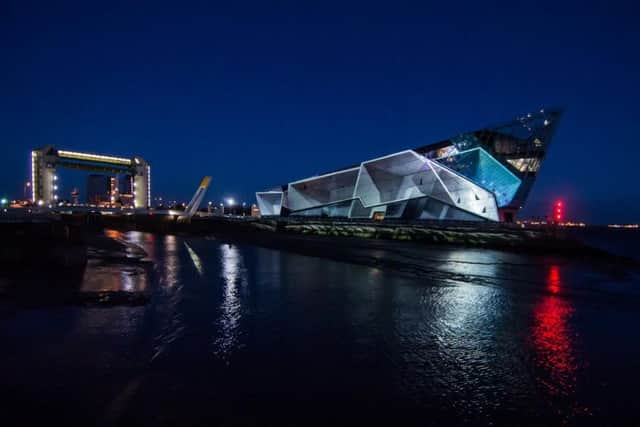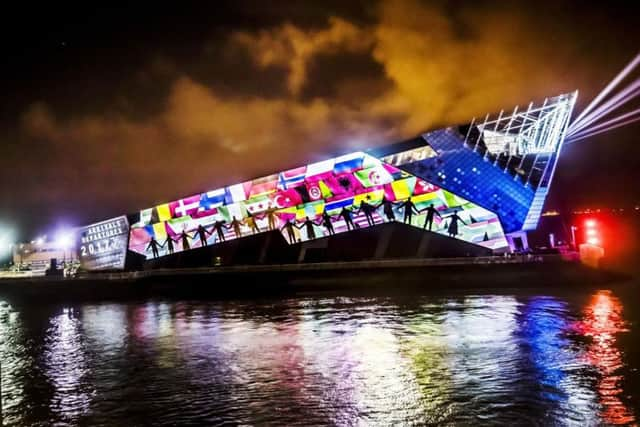How The Deep in Hull became the city's biggest success story


It was the collapse of the fishing industry that led to the desolate shipyards and abandoned warehouses that came to define Hull as it approached the Millennium.
Nobody thought that sea creatures would spark Hull's revival - but thanks to landmark visitor attraction The Deep, the city has an icon in its skyline once more and looks at the species that fed its people for generations from a different perspective.
Advertisement
Hide AdAdvertisement
Hide Ad

The world's first 'submarium' - a word invented as part of a canny marketing campaign - reached another milestone this autumn when the eight millionth visitor walked through the doors.
The Deep has been an incredible success - it pulls in around 450,000 visitors every year, is a popular destination for corporate entertaining, and is home to some of the world's leading marine experts. It was the project that was supposed to salvage Hull's post-industrial reputation, and it's worked when other Millennium legacy attractions have floundered.
Hatching an idea
In the late 1990s, Neil Porteus was an accountant at Hull City Council working on a project which was to change his career. Originally from Northallerton, he stayed in the city after completing a maths degree at the local university.


Advertisement
Hide AdAdvertisement
Hide AdHe was the finance lead tasked with securing funding for an ambitious visitor experience that could bring tourists to Hull. After The Deep opened in 2002, he was so inspired by its potential that he moved across and is now the attraction's deputy chief executive.
"We were finding that those who did visit Hull really enjoyed the museums and the maritime heritage, but there was nothing really big enough to get people here. At the time, the Lottery had launched a scheme to build landmark attractions around the UK to create a lasting legacy, and the two aims married up for us."
Neil was responsible for the capital programme and was successful in being awarded £19million of Lottery cash. It sounds like a huge amount, but was only half of the total needed to make a world-class aquarium a reality.


Advertisement
Hide AdAdvertisement
Hide AdThe solution was to become a charity, enabling the team to apply for a number of regeneration and support grants. The EU's development fund was one backer - Neil is keen to emphasize how Hull has benefitted from European investment. The city voted Leave in the referendum by an overwhelming 66 per cent, despite technology giant Siemens, who had committed to manufacturing turbine blades for North Sea wind farms in Hull, warning of the consequences for the local workforce.
More financial support came from government regeneration funds for deprived areas and the now-defunct Yorkshire Forward agency. The council gave land - in the form of a disused buoy depot that had once been a shipyard - to the charity and the University of Hull also became involved.
"We were fully-funded - we have never been in debt and even now we are self-sustaining, we don't rely on public support."
A strong link to the sea


When it came to choosing a focus for the project team's efforts, an aquarium seemed the perfect 'honeypot' - an accessible concept that would attract all ages of visitor while paying homage to Hull's maritime identity and providing a platform for globally significant research and conservation programmes.
Advertisement
Hide AdAdvertisement
Hide Ad"Hull has always made a living from the sea, whether that be whaling, fishing; there are strong connections. The Deep was about building new relationships with the ocean - we wanted to be more than just an aquarium, we wanted to tell the story of how the seas have formed. We tested the idea of a 'submarium' out on the streets - it's a made-up word but it meant that we wanted to get underneath the story."
The site chosen for The Deep was at the confluence of two rivers, the Hull and Humber, and offered the visually arresting location that Neil hoped would make it as recognisable as the Sydney Opera House.
They needed an eminent architect and they found one in Sir Terry Farrell, designer of the MI6 headquarters in London and the International Centre for Life in Newcastle. The world-renowned luminary 'loved' the site.
"The design really fits in well with the location."
The early days
With hindsight, Neil realises that relying on market research projections was The Deep's biggest, and perhaps only significant mistake. Surveys predicted that the new attraction would pull in 250,000 visitors in its first year, and the building's capacity was determined by these figures.
Advertisement
Hide AdAdvertisement
Hide Ad"We had to convince people that we were going to be sustainable at first. 250,000 people seemed quite a tall order - we are at the 'end of the line' in terms of rail and road access, and most of what would be our circular catchment area is under the North Sea!
"But we achieved 250,000 in the first three months and by the end of the year had welcomed 865,000 people. It was absolutely crazy. We soon realised that we were too small and would have to expand."
A further £5million in funding was secured for a £7million extension, and three years later it opened to the public.
"We had a bigger exhibition zone to increase dwell time, a shop that was four times bigger than before, a second cafe, new ticketing desks, a kitchen to serve an evening restaurant so we could start corporate events, and internal queuing space.
Advertisement
Hide AdAdvertisement
Hide Ad"Who could have predicted then that we would be so successful?"
The graveyard of Millennium projects
The Millennium Commission - a public body funded by the National Lottery - became notorious in the early 2000s for its legacy of high-profile failures, which included the flagship Millennium Dome in London, and within Yorkshire, Doncaster's Earth Centre and Sheffield's National Centre for Popular Music.
Neil initially feared that The Deep would lose out to rival Rotherham project Magna Science and Adventure Centre, but in the end both were awarded funding. The Deep avoided the 'Millennium curse' that seemed to seal the fate of the other legacy projects - the NCPM in Sheffield shut within a year and is now a students' union building, while the Earth Centre site is now used by an outdoor activity centre.
"I think the reason ourselves and the Eden Project in Cornwall have been a success is because we have 'living' exhibits which seem to capture people's imaginations. People come back again and again because we're a 'changing' exhibit.
Advertisement
Hide AdAdvertisement
Hide Ad"There are people in Hull who have never even been to The Deep but they are still proud of it and see it as an icon of their city. A quarter of our visitors are from the Hull area and it has really put Hull on the map."
Affordability, education and penguins
The Deep's management have always been sensitive to the region's demographics, and prices remain affordable - a £14 ticket can also be used as an annual pass for repeat visits. Every winter, there is a residents' weekend with £5 entry for anyone with a Hull postcode - this year it's expanding to include areas further afield too.
Educational visits for schoolchildren, which include classroom sessions, are subsidised.
But the biggest boost for The Deep came in 2014, when the attraction opened a penguin enclosure.
Advertisement
Hide AdAdvertisement
Hide Ad"They've been a real gamechanger for us - visitor numbers have increased by another 25-30 per cent. They have had several chicks now too, which people love. We also have two rescue turtles, but they haven't had quite the same impact as the penguins. We should have maybe introduced them sooner!
"We offer feeding experiences, but we will never do public diving in the tanks - there is a hierarchy in there and it would disturb the animals. We've introduced events like sleepover nights for children, but all new ideas have to have an educational benefit."
Shoots of recovery on the dockside
Although regeneration of the old docklands wasn't an initial aim of the council when they conceived The Deep, it has nonetheless happened gradually and organically, with the attraction as an anchor.
"There is a Premier Inn next door now, and a business centre. The Fruit Market area is regenerating. There were plans for massive investment in the area before the 2008 recession, and a bridge and car park were built before it was halted - but things are starting to happen again now. The council always use photos of The Deep in their marketing campaigns.
Advertisement
Hide AdAdvertisement
Hide Ad"BBC Look North feature The Deep in the background of their opening credits, and it's become as much of an icon as the Humber Bridge."
Looking to the future
Neil says the charity would like a bigger site - despite the eye-catching location, the geography of the land means further expansion is unlikely.
"We are quite constrained - the aesthetics are brilliant but there's nowhere to expand into.
"We haven't finalised our projects for next year yet - this year's was Glimpse, when we opened up areas behind the tanks to display the pump equipment that keeps the creatures alive. We are always looking for fresh ways to tell the story.
Advertisement
Hide AdAdvertisement
Hide Ad"We have a very stable management team and low staff turnover. A lot of young people start out with us thinking it will be a short-term weekend job and then go on to have a career here. There are a lot of them who have been with us since day one and it has a real family feel.
"Our chief executive, Katy Duke, moved from Scotland to start work here as an aquarist, looking after the fish. She then became a curator and when our last chief executive retired in 2017, she beat six or seven candidates from all over the world to get the job.
"I was seconded from the council to the team that was setting up The Deep, but I ended up moving over here permanently. It just felt right, like something amazing was going to happen."